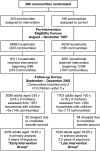Cash component of conditional cash transfer program is associated with higher body mass index and blood pressure in adults
- PMID: 18936227
- PMCID: PMC3151439
- DOI: 10.3945/jn.108.090506
Cash component of conditional cash transfer program is associated with higher body mass index and blood pressure in adults
Abstract
The cash component of Oportunidades, a large conditional cash transfer (CCT) program in Mexico, has previously been shown to be associated with better outcomes for child growth and development. The objective of this analysis was to determine whether the cash transfers were also associated with positive outcomes for adult health. Oportunidades was originally randomized across 506 rural (<2500 inhabitants) communities assigned to immediate incorporation into the program in 1997 or incorporation 18 mo later. Adults (n = 1649 early, n = 2039 late intervention) aged 18-65 y were then assessed in 2003. All of the households included in the analysis reported here complied with Oportunidades's requirements for the entire period, but some received higher cumulative cash transfers because they were living in communities randomized to begin receiving transfers earlier and/or they accumulated cash at a faster rate because they had more school-aged children at baseline. Our primary findings were that a doubling of cumulative cash transfers to the household was associated with higher BMI (beta = +0.83, 95% CI 0.46, 1.20; P < 0.0001), higher diastolic blood pressure (beta = +1.19, 95% CI 0.09, 2.29; P = 0.03), and higher prevalence of overweight [odds ratio (OR) = 1.41, 95% CI 1.18, 1.67; P < 0.0001), grade I obesity (OR = 1.41, 95% CI 1.14, 1.75; P = 0.002), and grade II obesity (OR = 1.57, 95% CI 1.05, 2.36; P = 0.03), while controlling for a wide range of covariates, including household composition at baseline. Oportunidades has been portrayed as a model for CCT programs worldwide, but the results reported here support the notion that the cash component of Oportunidades may be negatively associated with some adult health outcomes.
References
-
- Instituto Nacional de Salud Pública, editor. Encuesta Nacional de Salud y Nutrición [National Survey of Health and Nutrition]; 2006. [cited 2008 Sep 11]. Available from: http://www.insp.mx/ensanut/ensanut2006.pdf.
-
- Rivera JA, Barquera S, Campirano F, Campos I, Safdie M, Tovar V. Epidemiological and nutritional transition in Mexico: rapid increase of non-communicable chronic diseases and obesity. Public Health Nutr. 2002;5:113–22. - PubMed
-
- Filozof C, Gonzalez C, Sereday M, Mazza C, Braguinsky J. Obesity prevalence and trends in Latin-American countries. Obes Rev. 2001;2:99–106. - PubMed
Publication types
MeSH terms
LinkOut - more resources
Full Text Sources


